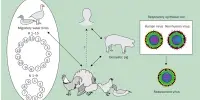It is possible that a study or research has recently discovered a second type of stem cell in the mouse brain. Stem cells are cells that have the potential to develop into many different types of cells in the body. The discovery of a new type of stem cell could provide new insights into the development and function of the brain, as well as potential new avenues for treating brain disorders. However, without more specific information it is not possible to provide more information.
Adult mammals’ brains contain neural stem cells, which ensure that new nerve cells, or neurons, are constantly formed. This process, known as adult neurogenesis, aids in the preservation of mice’s sense of smell. A research team led by Dr. Francesca Ciccolini at Heidelberg University’s Interdisciplinary Center for Neurosciences (IZN) recently discovered a second stem cell population in the mouse brain. This previously unknown type of stem cell is primarily involved in the production of new neurons in adult mice’s olfactory bulb.
Until now, scientific research on neurogenesis has focused on so-called apical stem cells. “They were long thought to be the only stem cell population in the adult mouse brain, as well as the primary driver of nerve cell formation,” Dr. Ciccolini explains. These neural stem cells are found near the lateral cerebral ventricle in the subventricular zone. They were once thought to be precursor cells that differentiate into interneurons, nerve cells that modulate stimuli transmission between interconnected neurons, in the olfactory bulb of mice. The Heidelberg researchers were able to debunk the single stem cell type theory as well as the assumption that apical stem cells are in charge of neurogenesis.
Our discovery that another stem cell type exists in the mouse brain of adult animals throws new light on the processes of neuron formation.
Dr. Ciccolini
Originally, the researchers in the Neurobiology department were investigating how this allegedly lone stem cell population in the mouse brain behaves in various situations. They used genetically modified animals whose neural stem cells were dyed green using a dye active in the cell nucleus. The neurobiologists were surprised to discover that most of the green cells did not display the known characteristics of apical stem cells. “At first, we thought that they could be astrocytes, helper cells that ensure that the neurons are able to do their work. But after we conducted a number of function analyses, it rapidly became clear that these had to be a separate stem cell population,” stresses Dr. Ciccolini.
Further studies showed that the newly discovered stem cell type differs from the known population in its morphology as well as its function. This type of cell has no contact with the lateral cerebral ventricle and is therefore called basal. The researchers determined that the basal — and not the apical – stem cells are responsible for the formation of neurons in the olfactory bulb. To prove this, they separately labelled both cell populations and then observed whether labelled neurons turned up in the olfactory bulb. “This only happened when the basal population was labelled,” explains Francesca Ciccolini. When only apical stem cells were labelled, no new labelled neurons could be detected in the olfactory bulb.

The Heidelberg scientists also found out that both stem cell types and precursor cells in the mouse brain communicate with one another via so-called notch interactions. A receptor of the same name plays a vital role, in controlling the speed at which the cells multiply and monitoring the cell differentiation process. “The notch activity decides, as it were, whether a stem cell remains a stem cell or develops into a nerve cell,” explains Katja Baur, a doctoral researcher in Francesca Ciccolini’s working group.
“We suspect that the apical stem cells intervene in the activation of the notch signal pathway and can inhibit proliferation and neurogenesis,” she adds. Amongst other things, that prevents the depletion of the stem cell reservoir.
“Our discovery that another stem cell type exists in the mouse brain of adult animals throws new light on the processes of neuron formation,” emphasizes Dr. Ciccolini. The human brain has similar stem cells that are involved in the formation of brain tumors. The Heidelberg researchers hope that their work will also shed new light on the development and possible treatment of such tumors.
















